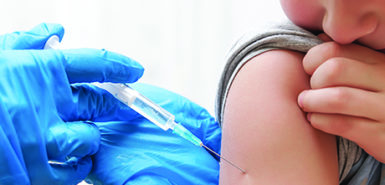
They are scenes every parent knows well during the school year:
- You’re awakened in the middle of the night by the distinct sound of vomiting.
- Your child walks into the kitchen one morning complaining of a sore throat and fever.
- Your child doesn’t want to eat his breakfast because his tummy hurts.
It’s not always easy to choose between sending your child to school and keeping him home. As it turns out, even those with a medical degree will tell you it’s not an exact science.
“There is not a nationally accepted agreement of what the absolutes are for when your child should be kept home from school,” said Bill Bush, MD, pediatrician-in-chief at Spectrum Health Helen DeVos Children’s Hospital.
Dr. Bush said the American Academy of Pediatrics and most pediatric offices provide guidelines to help parents determine if their child should be seen by a doctor, but there’s not necessarily anything to help them choose between a school day and a sick day.
“It’s complicated,” Dr. Bush said. “If this was really easy, then someone would have written a book that says, ‘If you have X, then you should do Y.’
“Every family is in a different situation,” he said. “We all know families who send their kids to school with lots of illnesses. And then there are families on the other side that will, with the mildest symptoms, keep their child home from school and say they have to be completely well before they return.”
Parents should also check with their school district to see what guidelines are in place for such cases. Some schools have more specific parameters than others.
Dr. Bush has some tips for parents choosing between a sick day and a school day:
- Fever: What’s considered a fever? For school-aged children, generally 101 degrees or higher is a fever. Keep your child home until he is fever-free for 24 hours without the use of fever-reducing medicine. “While it does depend on what the fever is associated with, it’s a good rule of thumb to stay home for another 24 hours to give your child time to be better prepared to go back to school, but also to spread fewer germs to the other kids,” Dr. Bush said.
- Strep throat: If your child has tested positive for strep throat, keep him home until he has been taking antibiotics for 24 hours.
- Vomiting: Your child needs to stay home until at least 24 hours has passed since he last vomited.
- Runny nose and cough: If a child’s coughing is disrupting class or keeping him and the other kids from concentrating, he should stay home and see a doctor to determine the cause. Dr. Bush offers a great tip: Ask if your child can actually learn anything based on how he’s feeling. A child with mild symptoms—a stuffy nose with clear discharge, or a mild cough—is likely able to go to school.
- Head lice: Any child with active lice needs to stay home and be treated. But, Dr. Bush said, many schools have revised their rules to modify the nit-free policy. Check with your school.
- Pink eye: A child with a diagnosed bacterial eye infection needs to stay home until he has been treated with anti-bacterial eye drops for 24 hours. Dr. Bush said the vast majority of eye infections are viral, not bacterial, and therefore do not require eye drops. Children with viral eye infections producing some discoloration and a small amount of clear drainage should be fine to attend school. A doctor can help determine what kind of infection your child has.
Dr. Bush urged parents to use their pediatrician’s office as a resource when their child is sick.
“Most doctors’ offices are well equipped to have parents call and talk to the nursing staff to make triage decisions,” he said. “If you have kept your child home from school and are not sure what the next day is going to bring, call your doctor’s office. We expect those calls and we expect to talk to a lot more families than we see in a day.”
 /a>
/a>
 /a>
/a>
 /a>
/a>